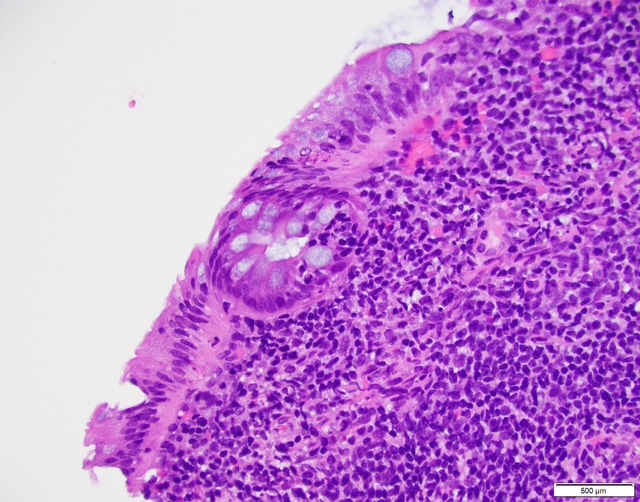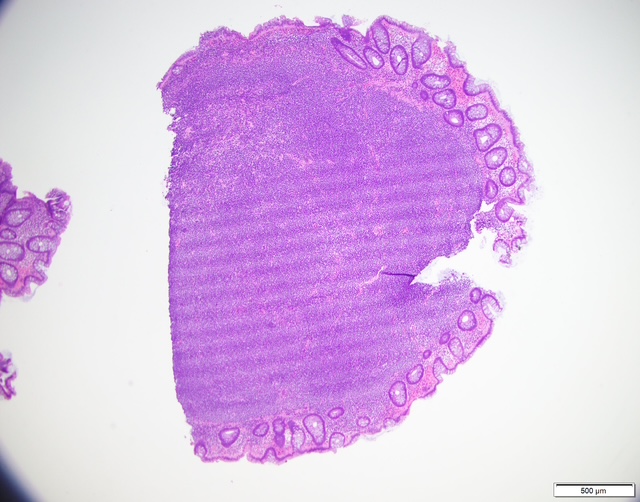Monday Poster Session
Category: Colon
P2462 - Incidental Finding of Colonic Mucosa-Associated Lymphoid Tissue (MALT) Lymphoma on Routine Colonoscopy
Monday, October 27, 2025
10:30 AM - 4:00 PM PDT
Location: Exhibit Hall
- AH
Anas M. Hasic, MD
Sarajevo School of Science & Technology
Saint Louis, MO
Presenting Author(s)
Anas M. Hasic, MD1, Sajid Zafar, MD2, Lamia M. Hasic, MD3, Muhammad Arsalan, MD4, Wagmah Khan, MD4
1Sarajevo School of Science & Technology, Saint Louis, MO; 2St. Luke's Hospital, Saint Louis, MO; 3Sarajevo School of Science & Technology, St. Louis, MO; 4St. Luke's Hospital, St. Louis, MO
Introduction: Mucosa-associated lymphoid tissue lymphoma (MALT) lymphoma, or MALToma, is a rare type of B-cell non-Hodgkin lymphoma which most commonly presents in the stomach, however may arise in different organs such as the small intestine, parotid gland, thyroid gland, colon, and elsewhere. Colonic MALTomas account for only 2.5% of all MALTomas and 5% of non-Hodgkin lymphomas. Due to its rarity, we present this case.
Case Description/
Methods: An asymptomatic 86 year-old male underwent routine screening colonoscopy recently which revealed six seemingly benign polyps and diverticulosis throughout the colon. His previous colonoscopy was normal, except for one tubular adenoma which was removed. He denied any symptoms in totality including constipation, diarrhea, and hematochezia. Laboratory results were unremarkable, except for mildly decreased platelets and slightly elevated blood urea nitrogen and creatinine, likely attributable to his past medical history of chronic kidney disease. The histopathology report indicated that one of the six polyps, which was a 10 mm polyp resected from the sigmoid colon via hot snare, depicted an atypical B-cell lymphoid aggregate on microscopy. A further panel of immunohistochemical stains was performed which showed strong CD20 positivity in the vast majority of the lymphocytes with dim co-expression of CD43 indicative of MALT lymphoma. There was also CD21 highlighting in small residual dendritic follicular networks. CT scan of chest, abdomen and pelvis is scheduled to assess for spread to any other tissues. An upper endoscopy will also be done to rule out the presence of a gastric MALToma. Helicobacter pylori testing is under consideration as part of a comprehensive workup, despite its stronger association with gastric MALTomas. Treatment is not unanimous but may include immunotherapy such as rituximab, chemotherapy, and/or H. pylori eradication.
Discussion: MALT lymphomas are an uncommon subset of non-Hodgkin lymphoma which primarily occur in the stomach but may occur in the lungs, ocular adnexa, small intestine, or colon as well. Colonic MALToma are commonly detected on routine screening colonoscopy and have a median age of presentation of 60 years old. They frequently appear endoscopically as benign sessile polyps. This case testifies to the importance of colonoscopy screenings due to the asymptomatic nature and benign appearance of MALTomas.

Figure: B-cell lymphoid aggregate on light microscopy

Figure: Light microscopy of the MALToma (low power-field)
Disclosures:
Anas Hasic indicated no relevant financial relationships.
Sajid Zafar indicated no relevant financial relationships.
Lamia Hasic indicated no relevant financial relationships.
Muhammad Arsalan indicated no relevant financial relationships.
Wagmah Khan indicated no relevant financial relationships.
Anas M. Hasic, MD1, Sajid Zafar, MD2, Lamia M. Hasic, MD3, Muhammad Arsalan, MD4, Wagmah Khan, MD4. P2462 - Incidental Finding of Colonic Mucosa-Associated Lymphoid Tissue (MALT) Lymphoma on Routine Colonoscopy, ACG 2025 Annual Scientific Meeting Abstracts. Phoenix, AZ: American College of Gastroenterology.
1Sarajevo School of Science & Technology, Saint Louis, MO; 2St. Luke's Hospital, Saint Louis, MO; 3Sarajevo School of Science & Technology, St. Louis, MO; 4St. Luke's Hospital, St. Louis, MO
Introduction: Mucosa-associated lymphoid tissue lymphoma (MALT) lymphoma, or MALToma, is a rare type of B-cell non-Hodgkin lymphoma which most commonly presents in the stomach, however may arise in different organs such as the small intestine, parotid gland, thyroid gland, colon, and elsewhere. Colonic MALTomas account for only 2.5% of all MALTomas and 5% of non-Hodgkin lymphomas. Due to its rarity, we present this case.
Case Description/
Methods: An asymptomatic 86 year-old male underwent routine screening colonoscopy recently which revealed six seemingly benign polyps and diverticulosis throughout the colon. His previous colonoscopy was normal, except for one tubular adenoma which was removed. He denied any symptoms in totality including constipation, diarrhea, and hematochezia. Laboratory results were unremarkable, except for mildly decreased platelets and slightly elevated blood urea nitrogen and creatinine, likely attributable to his past medical history of chronic kidney disease. The histopathology report indicated that one of the six polyps, which was a 10 mm polyp resected from the sigmoid colon via hot snare, depicted an atypical B-cell lymphoid aggregate on microscopy. A further panel of immunohistochemical stains was performed which showed strong CD20 positivity in the vast majority of the lymphocytes with dim co-expression of CD43 indicative of MALT lymphoma. There was also CD21 highlighting in small residual dendritic follicular networks. CT scan of chest, abdomen and pelvis is scheduled to assess for spread to any other tissues. An upper endoscopy will also be done to rule out the presence of a gastric MALToma. Helicobacter pylori testing is under consideration as part of a comprehensive workup, despite its stronger association with gastric MALTomas. Treatment is not unanimous but may include immunotherapy such as rituximab, chemotherapy, and/or H. pylori eradication.
Discussion: MALT lymphomas are an uncommon subset of non-Hodgkin lymphoma which primarily occur in the stomach but may occur in the lungs, ocular adnexa, small intestine, or colon as well. Colonic MALToma are commonly detected on routine screening colonoscopy and have a median age of presentation of 60 years old. They frequently appear endoscopically as benign sessile polyps. This case testifies to the importance of colonoscopy screenings due to the asymptomatic nature and benign appearance of MALTomas.

Figure: B-cell lymphoid aggregate on light microscopy

Figure: Light microscopy of the MALToma (low power-field)
Disclosures:
Anas Hasic indicated no relevant financial relationships.
Sajid Zafar indicated no relevant financial relationships.
Lamia Hasic indicated no relevant financial relationships.
Muhammad Arsalan indicated no relevant financial relationships.
Wagmah Khan indicated no relevant financial relationships.
Anas M. Hasic, MD1, Sajid Zafar, MD2, Lamia M. Hasic, MD3, Muhammad Arsalan, MD4, Wagmah Khan, MD4. P2462 - Incidental Finding of Colonic Mucosa-Associated Lymphoid Tissue (MALT) Lymphoma on Routine Colonoscopy, ACG 2025 Annual Scientific Meeting Abstracts. Phoenix, AZ: American College of Gastroenterology.
